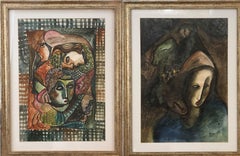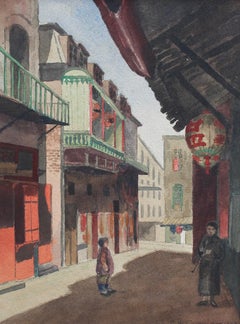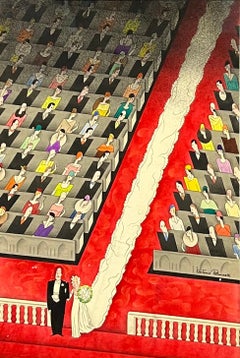Béla Kádár Art
Hungarian
Béla Kádár (1877–1956) was a Hungarian painter influenced by Der Blaue Reiter, Cubism, Futurism, Neo-Primitivism, Constructivism, and Metaphysical painting.
Kádár was born into a working-class Jewish family. After only six years of schooling he was apprenticed as an iron-turner. He began painting murals in Budapest. He visited Paris and Berlin in 1910 and by 1918 had moved to western Europe. He had his first important exhibition in October 1923 at Herwarth Walden's Galerie Der Sturm, in Berlin, showing work in an expressionist style. During the exhibition he met Katherine Dreier, who put on two exhibitions of his work at the Brooklyn Museum of Art in New York City, the second of which, in September 1928, Kádár attended.to
1
1
1
Overall Width
to
Overall Height
to
3
1
1
2
3
3
2
1
1
1
1
1
3
3
2
1
3
8,777
2,809
1,643
1,319
2
1
1
Artist: Béla Kádár
Mother and Child by Béla Kádár - Work on paper
By Béla Kádár, 1877-1955
Located in London, GB
*PLEASE NOTE UK BUYERS WILL ONLY PAY 5% VAT ON THIS PURCHASE.
Mother and Child by BÉLA KÁDÁR (1877-1955)
Gouache on paper
86 x 56.8 cm (33 7/8 x 22 3/8 inches)
Signed lower right Kádár Béla
This work is accompanied by a certificate of authenticity signed by Gábor Einspach on behalf of The First Hungarian Painting Expert's Office.
Provenance
Private collection, Israel
The Hungarian artist Béla Kádár was born in Budapest in 1877 to a working-class Jewish family. Following his father’s death, he was forced to start working from an early age after only six years to primary schooling and was apprenticed as an iron-turner. In 1902, Kádár attended the Academy of Fine Arts in Budapest. After leaving the Academy, he worked at a mural painting company. Only when he visited Berlin and Paris and being exposed to the avant-garde art of the time, did Kádár direct his attention to painting once again. In 1910, the artist won the Kohner prize, and the same year he was awarded his first solo exhibition at the Hungarian National Gallery. By 1918, Kádár moved to Western Europe. Today he is one of the most famous members of the early twentieth-century Hungarian avant-garde.
Over the course of his time living in Berlin, Kádár’s style changed. His expressionistic, graphic works were gradually replaced by paintings that were more romantic and delicate in nature. Incorporating and often synthesising stylistic elements of Cubism, Futurism, Constructivism, Neo-Primitivism and German Expressionism, Kádár’s decorative and metaphysical subject matter was often based upon traditional Hungarian folklore, and his subject-matter became increasingly narrative. His paintings in this period often feature surrealistic dream-like imagery, reminiscent of compositions by Marc Chagall. Despite his variety of subjects, ranging from abstracted figures and landscapes to interiors and objects, his paintings are typically rendered in a bright, jewel-toned palette and feature a fractured approach to rendering space.
In 1923 in Berlin, Kádár was invited by Herwath Walden to exhibit at the highly influential Galerie Der Sturm...
Category
1930s Expressionist Béla Kádár Art
Materials
Gouache
Double side portrait
By Béla Kádár, 1877-1955
Located in Jerusalem, IL
A unique piece by Hungarian artist Béla Kádár.
A double side watercolor painting featuring two beautiful scenes.
Category
Mid-20th Century Béla Kádár Art
Materials
Paper, Watercolor
Shadows
By Béla Kádár, 1877-1955
Located in West Hollywood, CA
Presenting an original mixed media watercolor by Hungarian artist Bela Kadar.
Bela Kadar was a historically important artist, is work was included as part of the degenerate art movement of Nazi Germany. His works appeared illustrated in the famous German arts magazine Der Sturm...
Category
1920s Expressionist Béla Kádár Art
Materials
Gouache
Price Upon Request
Related Items
Chinatown, San Francisco
By Edward Wilson Currier
Located in London, GB
'Chinatown, San Francisco', gouache on fine art paper, by Edward Wilson Currier (1903). Spofford Alley in San Francisco's Chinatown is best known for an address (number 36) where Dr. Sun Yat-Sen plotted the overthrow of China's last dynasty. During Prohibition, it was the site of turf battles over local bootlegging and protection rackets. Today it is lined with seniors' community centres. However, the quiet alley livens up in the evenings when a Chinese orchestra strikes up a tune, mah-jongg games begin with a cascade of clicking tiles, and barbers and florists use the pretence of sweeping their doorsteps to gossip. In this artist's depiction, a man smokes a long-stemmed Chinese pipe under the awning and colourful lanterns hanging from the wooden supports while a child looks on. The artwork is interesting from several standpoints including architectural, cultural and historical. Shortly after this work was painted, the neighbourhood was completely destroyed in the 1906 earthquake that levelled most of the city. From 1910 to 1940, Chinese immigrants were detained at the Angel Island...
Category
Early 1900s Expressionist Béla Kádár Art
Materials
Paper, Gouache
Original Painting. Colliers Magazine Cover Published 1933 Wedding Illustration
By Antonio Petruccelli
Located in New York, NY
Original Painting. Colliers Magazine Cover Published 1933 Wedding Illustration
Antonio Petruccelli (1907 - 1994)
The Wedding
Colliers published, June 17, 1933
17 1/4 X 11 1/2 inches (sight)
Framed 23 1/4 X 17 1/2 inches
Gouache on board
Signed lower right
BIOGRAPHY:
Antonio Petruccelli (1907-1994) began his career as a textile designer. He became a freelance illustrator in 1932 after winning several House Beautiful cover illustration contests.
In addition to 24 Fortune magazine covers, four New Yorker covers, several for House Beautiful, Collier’s, and other magazines he did numerous illustrations for Life magazine from the 1930s – 60s.
‘Tony was Mr. Versatility for Fortune. He could do anything, from charts and diagrams to maps, illustrations, covers, and caricatures,’ said Francis Brennan, the former art director for Fortune.
Over the course of his career, Antonio won several important design awards, designing a U.S. Postage Stamp Commemorating the Steel Industry and designing the Bicentennial Medal...
Category
1930s American Realist Béla Kádár Art
Materials
Gouache, Board
"Workers" Russian Constructivist 1920s Modern Social Realism Cubism Figurative
Located in New York, NY
"Workers" Russian Constructivist 1920s Modern Social Realism Cubism Figurative
VLADIMIR VASIL’EVICH LEBEDEV (1891-1967)
"Workers"
Gouache on paper
Monog...
Category
1920s Constructivist Béla Kádár Art
Materials
Paper, Gouache
Expressionist Gouache and Watercolour Study for 'Alexander and His Army'.
Located in Cotignac, FR
French late 20th century watercolour and gouache study for the series 'Alexander and His Army' by Stephane Lovighi-Bourgogne. Presented in plain wood frame.
A strong and forceful de...
Category
Late 20th Century Expressionist Béla Kádár Art
Materials
Paper, Watercolor, Gouache
$1,029
H 21.5 in W 27.5 in D 0.5 in
View of the Ovo Castle in the Moonlight, a 19th century Neapolitan gouache
Located in PARIS, FR
Neapolitan gouaches appeared in the eighteenth century when tourism in the Naples area was developing: the discoveries of Herculaneum and Pompeii made this city a mandatory stop on the Grand Tour, the journey made by wealthy Europeans to complete their education.
Generally small in size for ease of transport and affordable in price, these gouaches were the ideal travel souvenir that these tourists of the early days were bringing back to capture the idyllic landscapes they had discovered during their journey and to share them with family and friends upon their return at home.
The Bay of Naples and the eruptions of Vesuvius are the favourite themes of these views. Here we have a view of the Ovo Castle, which was rebuilt on the island of Partenope, in the middle of the Bay of Naples and about a hundred metres from the shore by the Normans in the 12th century on antique ruins...
Category
Early 19th Century Romantic Béla Kádár Art
Materials
Paper, Gouache
$1,680
H 12.19 in W 14 in
hree Freedoms - Worship, Communication and Assembly
Located in Los Angeles, CA
Three Freedoms - Worship, Communication and Assembly, February, 1960, mixed media on paper, signed lower right, 28 x 19 3/4 inches, exhibited Portrait of Freedom, Lehigh Art Alliance...
Category
1960s Béla Kádár Art
Materials
Paper, Watercolor, Gouache
$2,750
H 28 in W 19.75 in D 2 in
Emile's Tavern
By Lucien Génin
Located in London, GB
'Emile's Tavern', gouache on paper (circa 1930s), by Lucien Génin. A tavern in French is called a 'guinguette'. With the rise in living standards from the 1860s along with the develo...
Category
1930s Expressionist Béla Kádár Art
Materials
Paper, Gouache
Sacré-Coeur Montmartre at Willette Square Paris
By Lucien Génin
Located in London, GB
'Sacré-Coeur, Montmartre at Willette Square, Paris', gouache on art paper (circa 1930s), by Lucien Génin. Created by the Director of Public Ways and Promenades under Napoleon III, Sq...
Category
1930s Expressionist Béla Kádár Art
Materials
Paper, Gouache
$2,331 Sale Price
20% Off
H 16.93 in W 13.19 in
1910's Art Deco Erte Gouache Painting Original Hand Signed Rare French Costume
By Erté
Located in Buffalo, NY
A rare original signed Art Deco gouache on paper by Erte (Romain de Tirtoff)
.
This stunning theatrical costume design is signed Erte at the lower right.
The piece is 20 by 18 fram...
Category
1910s Art Deco Béla Kádár Art
Materials
Gouache, Archival Paper, Pencil
$6,400 Sale Price
20% Off
H 20 in W 18 in
Original Painting. New Yorker Mag Cover Proposal WPA Mid Century American Scene
By Antonio Petruccelli
Located in New York, NY
Original Painting. New Yorker Mag Cover Proposal WPA Mid Century American Scene
Antonio Petruccelli (1907 – 1994)
Perplexed Gentleman
New Yorker cover proposal, c. 1939
13 1/4 X 8 ...
Category
1930s American Modern Béla Kádár Art
Materials
Gouache, Board
Mid Century Gouache and Oil Pastel Figurative Painting 1960s Bay Area Female Art
By Gloria Dudfield
Located in Arp, TX
Gloria Dudfield
Yellow Purple Figure
1960s
Oil Pastel and Gouache on Paper
36"x28" unframed $800
*Custom framing available for additional charge. Please ...
Category
Mid-20th Century Abstract Béla Kádár Art
Materials
Paper, Oil Pastel, Gouache
$500
H 36 in W 28 in D 0.5 in
Contemporary Watercolor Painting, 'Design for Panel', C. 1994 by David Ruth
By David Ruth
Located in Oakland, CA
This is a contemporary abstract watercolor painting by artist David Ruth. This series of paintings often feature bright colors and vibrant layouts that draw the viewer in. They are c...
Category
1990s Abstract Expressionist Béla Kádár Art
Materials
Paper, Watercolor
Béla Kádár art for sale on 1stDibs.
Find a wide variety of authentic Béla Kádár art available for sale on 1stDibs. You can also browse by medium to find art by Béla Kádár in paint, paper, watercolor and more. Much of the original work by this artist or collective was created during the 20th century and is mostly associated with the modern style. Not every interior allows for large Béla Kádár art, so small editions measuring 10 inches across are available. Customers who are interested in this artist might also find the work of Albert Bertalan, Pierre Ambrogiani, and Alfred Kubin. Béla Kádár art prices can differ depending upon medium, time period and other attributes. On 1stDibs, the price for these items starts at $5,884 and tops out at $24,410, while the average work can sell for $9,141.




